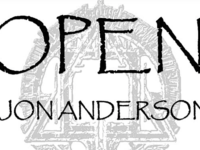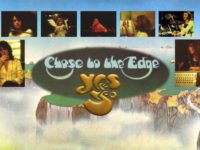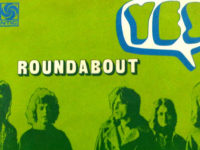Yes was flying high after the success of 1971’s ‘Fragile,’ their fourth album. With the addition of Rick Wakeman, the world’s greatest progressive rock band developed a gravitas in arranging epic songs like “Heart of the Sunrise” and “Roundabout.” They then entered Advision studios in London to create an historic follow up.
Released on Sept. 13, 1972, ‘Close to the Edge‘ represented a dramatic furthering of their creative process – and the second cycle of Yes albums without a change in personnel. These three long-form songs, recorded quickly by co-producer Eddie Offord, reflect significant contributions from all Yes members. Nowhere is this more apparent than the title track:
‘CLOSE TO THE EDGE’
“Close to the Edge” represented a slightly different approach to arranging and recording, as most of the parts where done live by Yes. Substantial overdubs where employed, however, and various pieces of compositions by Jon Anderson and Steve Howe were arranged together with input from Chris Squire, Eddie Offord and Rick Wakeman. The opening track, credited to Anderson and Howe, represents four movements over 18 minutes. The lyrics, written mostly by Jon Anderson, were inspired by the Hindu/Buddhist mysticism based on the book Siddhartha.
The first section, subtitled “The Solid Time of Change,” is mostly instrumental and covers numerous key and time signature changes. Steve Howe’s Gibson 335 provides a foil to Rick Wakeman’s Hammond organ, while Bill Bruford adds a complicated interaction with Chris Squire’s bass. Anderson’s presence is barely felt. Howe creates the main musical theme of the song in this section, before an abrupt switch in timing and timbre as Anderson finally joins in.
The “Total Mass Retain” section of the song switches the mood quickly as Howe leads the band into a brief boil which is capped off by Bruford’s tom-tom fill. Anderson and Squire sing in tandem during the section with uncanny precision. Again, the pace and key changes. Remarkably, Squire plays a sliding and punctuated bass part while he and Anderson sing a vocal together which is in a different time signature than the music. The pace is even more frenzied as Anderson delivers a lead vocal which contrasts with the music, in power and precision. Wakeman debuts several Moog and mellotron sounds into the mix.
“I Get Up, I Get Down” follows in rapid succession. Again, the pace changes as Steve Howe’s electric sitar compliments Rick Wakeman’s Hammond organ and mellotron orchestration. The shift is dramatic and stunning. Wakeman’s presence is almost overshadowed by the harmony vocals provided by Chris Squire and Howe. Jon Anderson’s vocal stays with the main theme, while Squire and Howe brilliantly provide a contrast. If “Close to the Edge” were to end here most would be satisfied, but after Wakeman’s church organ interlude we are treated to the final section, subtitled “Seasons of Man.”
The frenzy starts again, kicked off my Wakeman’s forceful synthesizer and the galloping charge of Bill Bruford’s jazzy back beat. Wakeman then steps over to deliver a Tony Kaye-worthy Hammond organ solo before a recapitulation of the main musical theme. All the prior musical themes are repeated in this section, before the song wraps up and the listener is left exhausted and fully satisfied.
Close to the Edge was clearly a high-water mark for Yes at the time, and the original album has two more classic songs which have significantly impacted the Yes canon of work. No wonder the title song tops many lists of the greatest progressive rock songs ever.
‘AND YOU AND I’
“… Oh, coins and crosses never know their fruitless worth
Cords are broken locked inside the mother earth
They won’t hide, they won’t tell you
Watching the world, watching all of the world
Watching us go by
And you and I climb over the sea to the valley
And you and I reached out for reasons to call …”
The first bridge to Yes’ “And You and I” hints at the epic nature of the song. However, there are so many elements that make this four-part opus an enduring classic alongside the title track of Close to the Edge. Jon Anderson has often claimed these lyrics are a protest to several things. There are elements of environmentalism and activism in his words. Anderson also comes back to an often-explored theme of searching for greater meaning to life in the lyrics. Whatever the narrative is intended to mean, Anderson and cowriters Chris Squire, Steve Howe and Bill Bruford weave the lyrics into a thematic landscape.
“Chord of Life” starts with a plaintive 12-string acoustic guitar. This, the longest of the four sections in “And You and I” at almost four minutes, quickly develops as Bruford’s muted floor toms and chimes set the foundation for Rick Wakeman’s keyboard break. In short order, Anderson paints the initial brush stroke. The first two verses are delivered in rapid succession, then a counter melodic verse is sung by Squire and Howe as all of Yes then picks up the pace.
“Eclipse” quickly follows after Squire delivers a trademark harmony with Anderson. In “Eclipse,” Howe delivers a swooping steel guitar run, as Wakeman builds tension with string effects. Moog bass parts are also part of the foundation. Are they from Squire or Wakeman? In any case the steel guitar, Moog bass and Wakeman’s Hammond B3 created a foundation for Anderson’s restating of the main lyrical theme. Just as Yes’ song is about to peak, Howe tamps down the fire with his 12-string guitar.
“The Preacher, The Teacher” begins with a folk-type melody, were Wakeman quickly adds Moog accents and Squire incorporates harmonica. Then, the mood shifts from pensive to jaunty as Howe enters with a brief, yet effective electric guitar break played over a mid-tempo rock back beat provided by Bruford. Anderson and Squire complete a recapitulation of Yes’ main theme.
“Apocalypse” marks a fitting end to the masterpiece, with Howe’s steel guitar returning with more zeal and delay than before. Squire works his Rickenbacker bass in tandem with bass pedals, which threaten to rattle the entire room. But before that happens, Wakeman’s piano sweeps lead the world’s greatest progressive rock band back to the beginning theme.
The opening track on Close to the Edge may be longer, but “And You and I” may truly be Yes at the peak of its powers.
‘SIBERIAN KHATRU’
The closing song from 1972’s Close to the Edge has earned a unique place in the Yes canon. “Siberian Khatru” is often the go-to concert opener, and is among the most played and anticipated selections in their shows.
Like its album mates, the song can hardly be called your typical rock fare. Jon Anderson’s lyrics are as oblique as they are obtuse. Unlike the title track, Anderson sings a melodic and perfectly synced vocal. However, Anderson does tie in even more mystical elements. What is Anderson singing about? It doubtful even he knew, but the words flow perfectly with the melody provided by cowriters Steve Howe and Rick Wakeman.
Howe employs a number of effective guitar textures. His Gibson 335 sound kicks off with a clean, direct and precise theme. Howe then leads the rhythm section through a direct dance, which is quickly followed by Rick Wakeman’s string-like mellotron. The fray is driven by a deceptively simple Bill Bruford backbeat. Don’t be fooled: Bruford serves up the polyrhythms with the best of them.
After the adventurous intro, Yes’ time signature becomes a little more conventional. Both Howe and Wakeman get to shine in a variety of ways. Howe seamlessly moves from his Gibson to his Fender pedal steel and back, providing a brief and almost other-worldly solo, while Wakeman utilizes his harpsichord with equal dexterity. The interplay between the two on “Siberian Khatru” is a highlight of the album. Not to be outdone, Bruford and Chris Squire’s interplay reaches even greater heights.
With a recapitulation of the main theme, Jon Anderson brings everything back into focus – only to be launched again by Wakeman’s mellotron. Just when you think it will all come crashing down, Anderson quickly and forcefully concludes the proceedings in concert with the rest of the band.
Yes’ “Siberian Khatru” is all the more amazing since this song, like the preceding two, was painstakingly put together by the band with little arranging done before the recording sessions. In the end, this process was too convoluted for Bruford who left for a long stint with King Crimson after the recording sessions.
Bruford wouldn’t get the pleasure of playing these songs with Yes’ official lineup until the Union tour. By then, replacement Alan White was well on his way to becoming the band’s longest-tenured member.
- Nosotros, “Mentiras” (2024): One Track Mind - April 10, 2024
- Nick Finzer, Christian Fabian, Rachel Z + Others: Five for the Road - April 5, 2024
- Terry Blade on ‘Ethos: Son of a Sharecropper’: Something Else! Interview - March 10, 2024




